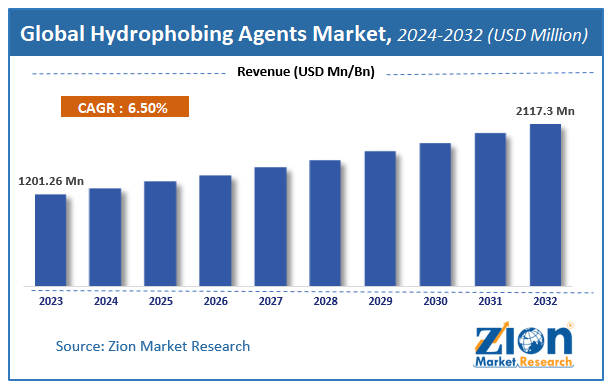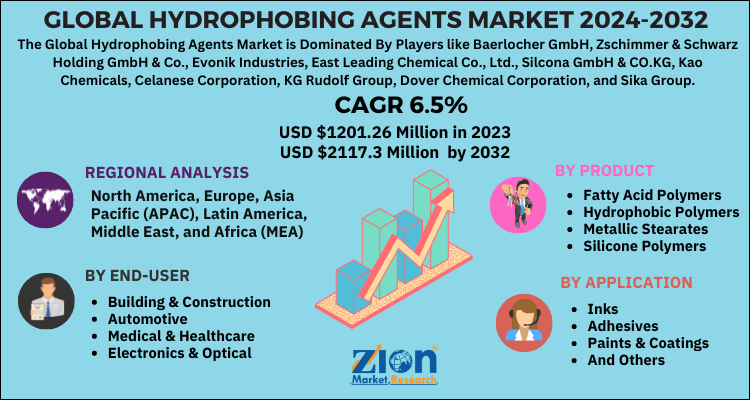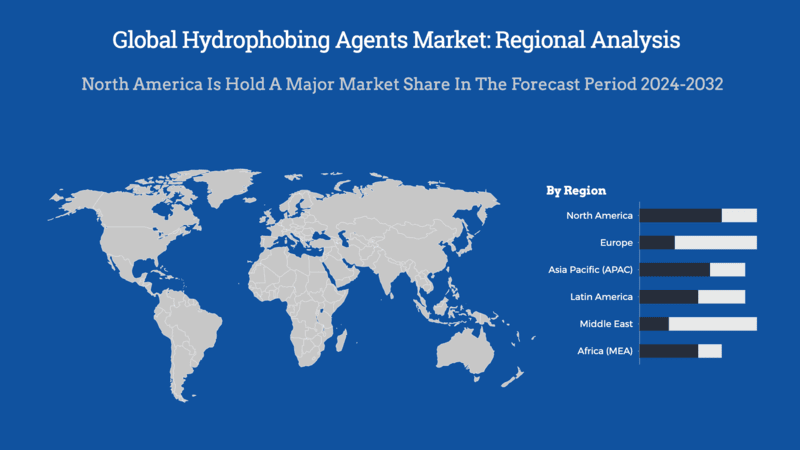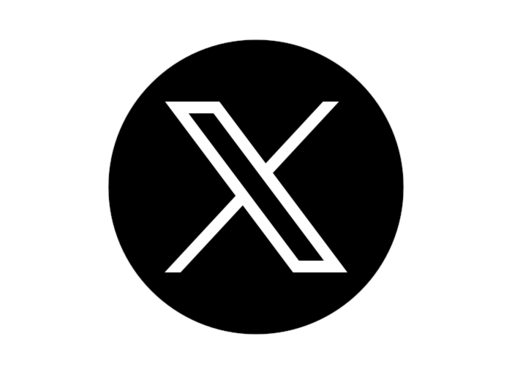Hydrophobing Agents Market Size, Share, Growth & Trends 2032

Hydrophobing Agents Market By application (inks, adhesives, paints & coatings, and others), By product (fatty acid polymers, hydrophobic polymers, metallic stearates, and silicone polymers), By end-user (building & construction, automotive, medical & healthcare, electronics & optical, and others) And By Region: - Global And Regional Industry Overview, Market Intelligence, Comprehensive Analysis, Historical Data, And Forecasts, 2024-2032
| Market Size in 2023 | Market Forecast in 2032 | CAGR (in %) | Base Year |
|---|---|---|---|
| USD 1201.26 Million | USD 2117.3 Million | 6.5% | 2023 |
Description
Hydrophobing Agents Market Insights
According to the report published by Zion Market Research, the global Hydrophobing Agents Market size was valued at USD 1201.26 Million in 2023 and is predicted to reach USD 2117.3 Million by the end of 2032. The market is expected to grow with a CAGR of 6.5% during the forecast period. The report analyzes the global Hydrophobing Agents Market's growth drivers, restraints, and impact on demand during the forecast period. It will also help navigate and explore the arising opportunities in the Hydrophobing Agents industry.
Global Hydrophobing Agents Market: Overview
Hydrophobing agents which are also commonly known as hydrophobic agents are surface protection materials that minimize the water absorption and make sure the water-repellent effect on the cleaned surface. These agents reduce the penetration of water in concrete by increasing the angle of contact between the concrete surface and water. The hydrophobing agents have numerous applications in several sectors including construction, paints & coating, automobiles, and personal care.
Global Hydrophobing Agents Market: Growth Factors
The demand for hydrophobing agents is increasing at a faster pace. The rise in demand for hydrophobing agents for the coating of electronic gadgets to prevent them from moisture, chemicals, and water is propelling the growth of the global hydrophobing agents market. In addition to this, rapid growth in the personal care sector and huge investments in social & economic infrastructure are the key factors that are fostering the growth of the global market. Hydrophobing agents are been widely used in the construction sector to enhance the durability of building materials that are exposed to moisture. These agents prevent efflorescence of salts, frost damage & water absorption, protect sub-layers, maintain the appearance & functionality of the building material, extend the service life of the building as well as the period between renovation, and also save the cost of expensive raw materials.
Owing to all these factors and the increase in commercial residential projects, there is a huge demand for hydrophobing agents from the construction sector which is majorly contributing to the growth of the global market. Moreover, the rapidly expanding automobile industry and the growing use of hydrophobing agents in paints & coatings as well as the healthcare sector are also the additional factors that are spurring the growth of the market. Furthermore, continuous investments in R&D for the launch of new products by the key players may create several opportunities for the growth of the global hydrophobing agents market during the forecast period. However, high initial investments and stringent regulations associated with the use of hydrophobing agents as it releases volatile organic compounds are the factors that may hamper the growth of the global hydrophobing agents market.
The Covid-19 pandemic has led to the global economic crisis. The government had to make a quick decision of complete lockdown and impose stay-at-home orders to control the spread of the virus. Due to this, the manufacturers of hydrophobing agents had to face unprecedented effects as they had to cease all their operations during the pandemic. In addition to this, the disruption of the supply chain hampered the availability of the raw material and the restriction on transport & personnel movement are also the factors that adversely affected the growth of the global hydrophobing agents market. Moreover, the decrease in demand for hydrophobing agents from its end-users has also impacted the market growth.
Key Insights
- As per the analysis shared by our research analyst, the global Hydrophobing Agents Market is estimated to grow annually at a CAGR of around 6.5% over the forecast period (2024-2032).
- In terms of revenue, the global Hydrophobing Agents Market size was valued at around USD 1201.26 Million in 2023 and is projected to reach USD 2117.3 Million by 2032.
- Based on the application, the Building & Construction this segment leads the market, driven by the use of hydrophobing agents to enhance water resistance and durability in materials like plaster, fiber boards, and concrete.
- Based on the product, the Metallic Stearates among product types, metallic stearates hold the largest market share due to their anti-water absorption, lubricating, and separating characteristics, making them suitable for various industrial applications.
- Based on the end-user, the Building & Construction this sector is the primary consumer of hydrophobing agents, utilizing them to improve the longevity and performance of construction materials exposed to moisture.
- Based on the region, the North America is the leading region in the hydrophobing agents market, attributed to significant investments in infrastructure and the need for water-repellent chemicals in construction.
Hydrophobing Agents Market: Dynamics
Key Growth Drivers
The hydrophobing agents market is primarily driven by the increasing demand for water-repellent materials across various industries, including construction, textiles, automotive, and packaging. In the construction sector, hydrophobing agents are widely used to enhance the durability and longevity of concrete, masonry, and other building materials by preventing water absorption and damage. Additionally, the rising preference for eco-friendly and sustainable products has led to the development of bio-based hydrophobing agents, further driving market growth. Advancements in nanotechnology and surface treatment technologies also contribute to the improved performance and adoption of hydrophobing agents across different applications.
Restraints
Despite favorable growth prospects, the market faces several restraints, including stringent environmental regulations governing the use of certain chemical-based hydrophobing agents. Some formulations may release volatile organic compounds (VOCs), leading to concerns over air quality and human health. The high cost of specialty hydrophobing agents can also hinder their widespread adoption, particularly in price-sensitive markets. Additionally, the availability of alternative water-repellent materials and substitutes may pose a challenge to market expansion. Manufacturers may also face difficulties in maintaining consistent product performance across diverse applications and environmental conditions.
Opportunities
The growing emphasis on sustainable construction practices presents significant opportunities for the hydrophobing agents market. Innovations in bio-based and environmentally friendly formulations are gaining traction, particularly in regions with strict environmental regulations. Additionally, the increasing use of hydrophobing agents in the textile and apparel industry, driven by the demand for water-resistant and stain-repellent fabrics, creates new growth avenues. The expansion of the automotive and packaging sectors, where hydrophobic coatings are used to enhance product longevity and functionality, also provides promising opportunities. Emerging markets in Asia-Pacific and Latin America, with their growing infrastructure and industrialization, further contribute to market growth.
Challenges
One of the key challenges facing the hydrophobing agents market is the need for continuous research and development to create sustainable and high-performance products. Developing cost-effective and environmentally friendly alternatives without compromising product quality remains a complex task for manufacturers. Additionally, fluctuating raw material prices and supply chain disruptions can impact production costs and product pricing. The lack of awareness and technical expertise in certain regions may also limit market penetration. Furthermore, achieving regulatory compliance across different countries and regions can be challenging for global market players, requiring significant time and resources for product testing and certification.
Hydrophobing Agents Market: Report Scope
| Report Attributes | Report Details |
|---|---|
| Report Name | Hydrophobing Agents Market |
| Market Size in 2023 | USD 1201.26 Million |
| Market Forecast in 2032 | USD 2117.3 Million |
| Growth Rate | CAGR of 6.5% |
| Number of Pages | 214 |
| Key Companies Covered | Baerlocher GmbH, Zschimmer & Schwarz Holding GmbH & Co., Evonik Industries, East Leading Chemical Co., Ltd., Silcona GmbH & CO.KG, Kao Chemicals, Celanese Corporation, KG Rudolf Group, Dover Chemical Corporation, and Sika Group |
| Segments Covered | By Application, By Product, By End-user And By Region |
| Regions Covered | North America, Europe, Asia Pacific (APAC), Latin America, Middle East, and Africa (MEA) |
| Base Year | 2023 |
| Historical Year | 2018 to 2022 |
| Forecast Year | 2024 - 2032 |
| Customization Scope | Avail customized purchase options to meet your exact research needs. Request For Customization |
Global Hydrophobing Agents Market: Segmentation
The global hydrophobing agents market is categorized based on application, product, end-user, and region. All the segments have been analyzed based on present and future trends and the market is estimated from 2024 to 2032.
Based on the application, the global hydrophobing agents market is bifurcated into inks, adhesives, paints & coatings, and others.
Based on the product, the global market is classified into fatty acid polymers, hydrophobic polymers, metallic stearates, and silicone polymers.
The end-user market is divided into building & construction, automotive, medical & healthcare, electronics & optical, and others.
The regional segment includes the current and forecast demand for North America, Europe, Asia Pacific, Latin America, and the Middle East and Africa.
Global Hydrophobing Agents Market: Regional Analysis
North America is projected to lead the global hydrophobing agents market in terms of revenue followed by Europe. Factors such as rise in investment for infrastructure in private & public sectors, growing need for the replacement of aged construction sites, and increase in need for water-repellent chemicals for building & construction purposes boost the growth of North America market. The market in Europe is expected to rise due to the presence of paint & coating industries and the growing demand for hydrophobing agents from electronics industries. On the other hand, Asia Pacific region is predicted to grow rapidly during the forecast period due to a rise in economic growth leading to invest majorly for the development of infrastructure, increase in demand for personal care products, and expanding cosmetic industries.
The hydrophobing agents market demonstrates varied growth patterns across different regions, influenced by factors such as industrialization, infrastructure development, and sector-specific demands.
Asia Pacific
Asia Pacific is poised to experience significant growth in the hydrophobing agents market, with projections estimating the market will reach approximately USD 707 million, reflecting a compound annual growth rate (CAGR) of 5% from 2024 to 2032. This expansion is driven by rapid industrialization, urbanization, and substantial infrastructure projects in countries like China and India. The burgeoning construction sector and increasing demand for water-resistant materials are key contributors to this growth.
North America
North America holds a significant share of the hydrophobing agents market, attributed to robust construction and automotive industries. The region's focus on sustainable and eco-friendly solutions, coupled with stringent environmental regulations, promotes the adoption of advanced hydrophobing technologies. The need for water-repellent coatings in construction applications further drives market demand.
Europe
Europe represents a mature market with steady growth, supported by established construction, automotive, and personal care sectors. The region's commitment to sustainability and stringent environmental regulations encourages the use of eco-friendly hydrophobing agents. Additionally, Europe's advanced manufacturing capabilities and innovation in product formulations contribute to market expansion.
Latin America and Middle East & Africa
Emerging markets in Latin America and the Middle East & Africa are showing promising growth potential. Factors such as increasing investments in infrastructure, urbanization, and rising consumer awareness of water-resistant materials drive demand for hydrophobing agents. Government initiatives and infrastructure projects in countries like Brazil, Mexico, Saudi Arabia, and the UAE further bolster market growth.
Global Hydrophobing Agents Market: Competitive Players
Some of the key manufacturers operating in the global hydrophobing agents market are:
- Baerlocher GmbH
- Zschimmer & Schwarz Holding GmbH & Co.
- Evonik Industries
- East Leading Chemical Co., Ltd.
- Silcona GmbH & CO.KG
- Kao Chemicals
- Celanese Corporation
- KG Rudolf Group
- Dover Chemical Corporation
- Sika Group.
The Global Hydrophobing Agents Market is segmented as follows:
By Application
- Inks
- Adhesives
- Paints & Coatings
- And Others
By Product
- Fatty Acid Polymers
- Hydrophobic Polymers
- Metallic Stearates
- Silicone Polymers
By End-user
- Building & Construction
- Automotive
- Medical & Healthcare
- Electronics & Optical
- And Others
Global Hydrophobing Agents Market: Regional Segment Analysis
- North America
- The U.S.
- Canada
- Europe
- France
- The UK
- Spain
- Germany
- Italy
- Rest of Europe
- Asia Pacific
- China
- Japan
- India
- South Korea
- Southeast Asia
- Rest of Asia Pacific
- Latin America
- Brazil
- Mexico
- Rest of Latin America
- Middle East & Africa
- GCC
- South Africa
- Rest of Middle East & Africa
What Reports Provides
- Full in-depth analysis of the parent market
- Important changes in market dynamics
- Segmentation details of the market
- Former, on-going, and projected market analysis in terms of volume and value
- Assessment of niche industry developments
- Market share analysis
- Key strategies of major players
- Emerging segments and regional markets
- Testimonials to companies in order to fortify their foothold in the market.
Table Of Content
FrequentlyAsked Questions
The rise in demand for hydrophobing agents for the coating of electronic gadgets to prevent them from moisture, chemicals, & water is propelling the growth of the global hydrophobing agents market. Furthermore, continuous investments in R&D for the launch of new products by the key players may create several opportunities for the growth of the global hydrophobing agents market during the forecast period.
Some of the key manufacturers operating in the global hydrophobing agents market are Baerlocher GmbH, Zschimmer & Schwarz Holding GmbH & Co., Evonik Industries, East Leading Chemical Co., Ltd., Silcona GmbH & CO.KG, Kao Chemicals, Celanese Corporation, KG Rudolf Group, Dover Chemical Corporation, and Sika Group.
North America is projected to lead the global hydrophobing agents market in terms of revenue followed by Europe. Factors such as rise in investment for infrastructure in private & public sectors, growing need for the replacement of aged construction sites, and increase in need for water-repellent chemicals for building & construction purposes boost the growth of North America market.
HappyClients
Zion Market Research
Tel: +1 (302) 444-0166
USA/Canada Toll Free No.+1 (855) 465-4651
3rd Floor,
Mrunal Paradise, Opp Maharaja Hotel,
Pimple Gurav, Pune 411061,
Maharashtra, India
Phone No +91 7768 006 007, +91 7768 006 008
US OFFICE NO +1 (302) 444-0166
US/CAN TOLL FREE +1 (855) 465-4651
Email: sales@zionmarketresearch.com
We have secured system to process your transaction.
Our support available to help you 24 hours a day, five days a week.
Monday - Friday: 9AM - 6PM
Saturday - Sunday: Closed








